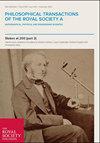面向智能结构卫星的降阶H∞控制器设计
Philosophical Transactions of the Royal Society of London. Series A, Mathematical and Physical Sciences
Pub Date : 2001-11-15
DOI:10.1098/rsta.2001.0885
引用次数: 11
摘要
本文针对高阶智能结构系统,设计了一种低阶控制器。这里考虑的应用程序是一个动态类似于卫星上使用的太阳能电池板模型。智能结构是指在结构系统中使用集成的压电陶瓷材料作为传感器和执行器来实现控制。通过将高频鲁棒条件与剩余不确定性联系起来,扩展了众所周知的鲁棒控制理论,从而消除了常规鲁棒控制设计中的试错步骤,从而做出了分析贡献。该方法在一个半米长的弯曲和扭转耦合框架上进行了实验,验证了该技术对于一个相当复杂的结构是可行的。本文章由计算机程序翻译,如有差异,请以英文原文为准。
Design of a reduced–order H∞ controller for smart structure satellite applications
In this paper, the design of a low–order controller for a high–order, smart–structural system is presented. The application considered here is a model of a solar panel dynamically similar to those used on satellites. Smart structure refers here to the use of integrated piezoceramic materials as sensors and actuators in the structural system in order to implement the control. The analytical contribution is made by extending the well–known robust control theory by relating the high–frequency robustness condition to the residual uncertainty, removing a trial–and–error step in the normal robust–control design. The procedure is applied experimentally to a half–metre long frame that is coupled in bending and torsion, verifying that the technique is viable for a reasonably complex structure.
求助全文
通过发布文献求助,成功后即可免费获取论文全文。
去求助
来源期刊
自引率
0.00%
发文量
0

 求助内容:
求助内容: 应助结果提醒方式:
应助结果提醒方式:


